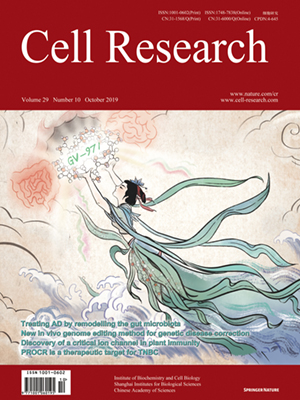
Volume 29, No 10, Oct 2019
ISSN: 1001-0602
EISSN: 1748-7838 2018
impact factor 17.848*
(Clarivate Analytics, 2019)
Volume 29 Issue 10, October 2019: 866-869 | Open Access
LETTERS TO THE EDITOR
Maternal exposure to triclosan constitutes a yet unrecognized risk factor for autism spectrum disorders
Zijian Hao1, Qionghui Wu2, Zhengwei Li1, Yali Li1, Qiu Li2, Xi Lai2,Huan Liu2, Menghuan Zhang1, Ting Yang2, Jie Chen2,Yaping Tang 3,4, Jingkun Miao5, Huatai Xu6, Tingyu Li2 and Ronggui Hu 1
1University of Chinese Academy of Sciences; State Key Laboratory of Molecular Biology, CAS Center for Excellence in Molecular Cell Science, Institute of Biochemistry and Cell Biology, Chinese Academy of Sciences, Shanghai 200031, China; 2Pediatric Research Institute, Children’s Hospital of Chongqing Medical University, Chongqing Key Laboratory of Child Nutrition and Health, Chongqing 400014, China; 3Guangdong Provincial Key Laboratory of Brain Function and Disease, Zhongshan School of Medicine, Sun Yat-sen University, Guangzhou, Guangdong 510080, China; 4Guangzhou Institute of Pediatrics, Guangzhou Women and Children’s Medical Center, Guangzhou Medical University, Guangzhou, Guangdong 510623, China; 5Neonatal Screening Center, Chongqing Women and Children’s Medical Center, Chongqing 401174, China and 6Shanghai Institute of Neurosciences, Shanghai Institutes for Biological Sciences,Chinese Academy of Sciences, Shanghai 200031, China
These authors contributed equally: Zijian Hao, Qionghui Wu.
Correspondence: Tingyu Li (tyli@vip.sina.com) orRonggui Hu (coryhu00@gmail.com)
Dear Editor,
Autism spectrum disorders (ASD) are complex neurodevelopmental disorders characteristic of core behavioral traits like restricted, repetitive behaviors and deficiency in social interactions.1 The prevalence of ASD has rapidly increased worldwide, rising from 1/149 in 2000, 1/68 in 2012, and to ~1/40 in 2016 of children at the age of 3–17 in the United States.2 ASD prevalence was found to be associated with socioeconomic status (SES) as overpresented in high-income households,3 and to be significantly enriched in certain regions, e.g., reaching up to 4.88% in Florida.2 In the last decades, advances in genetic studies have led to unprecedented understanding of the genetic factors that were associated with < 50% of human ASD. Tens of thousands of genomic events or gene mutations were found in ASD patients. Among these genetic factors, many seemed to indeed play causal roles in ASD etiology as animals bearing some of ASD-associated mutations manifested autistic-like behaviors.4,5,6,7 Since genetic factors are usually SES independent and unlikely to change in every few years, non-genetic factors including changes in life styles, environmental factors and their complex interaction with genetic factors are believed to prominently contribute to the recent rapidly increasing ASD prevalence.4,5,6 However, their nature and mechanisms of action remain largely undetermined.
https://doi.org/10.1038/s41422-019-0220-1
FULL TEXT | PDF
Browse 1085


